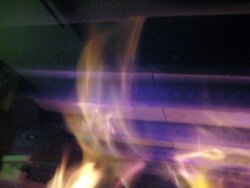My fires burn too fast and I think I'm losing a lot of the heat up the flue. I think there might be too much draft. It seems like the stove uses up the wood real fast and I don't want to just waste the wood I went through so much trouble to split and store.
Background:
A couple of months ago, I had a Kodiak 1700 Insert half-installed with an insulated 6" SS liner straight up a 20 foot chimney. I say half-installed, because they are going to come back and install the block-off plate and replace the crown on top of the chimney. After 2.5 months, they finally got back in touch with me and want to do the second half of the install (and also collect the second half of the payment).
Draft: The stove is in the basement, my house is by no means airtight. Smoke used to come out when I would start a fire when the stove was cold, but I followed some advice in these forums and use a propane torch before lighting a fire to get the draft going. I don't have any smoke problems now.
There's no separate control for the secondary air tubes on the stove insert.
Pictures & Videos:
-- Does this pic show the flame and heat going up the flue and being wasted?
http://www.flickr.com/photos/21339555@N06/3386361014/in/set-72157615904575506
-- A video that I think shows my precious heat going up the flue.
-- The hole where the blockoff plate will be:
http://www.flickr.com/photos/21339555@N06/3386361056/in/set-72157615904575506
So, do I have too much draft? Any tests I should do? Anything I should ask the installers to do when they come back?
Any help / advice would be very much appreciated!
Background:
A couple of months ago, I had a Kodiak 1700 Insert half-installed with an insulated 6" SS liner straight up a 20 foot chimney. I say half-installed, because they are going to come back and install the block-off plate and replace the crown on top of the chimney. After 2.5 months, they finally got back in touch with me and want to do the second half of the install (and also collect the second half of the payment).
Draft: The stove is in the basement, my house is by no means airtight. Smoke used to come out when I would start a fire when the stove was cold, but I followed some advice in these forums and use a propane torch before lighting a fire to get the draft going. I don't have any smoke problems now.
There's no separate control for the secondary air tubes on the stove insert.
Pictures & Videos:
-- Does this pic show the flame and heat going up the flue and being wasted?
http://www.flickr.com/photos/21339555@N06/3386361014/in/set-72157615904575506
-- A video that I think shows my precious heat going up the flue.
-- The hole where the blockoff plate will be:
http://www.flickr.com/photos/21339555@N06/3386361056/in/set-72157615904575506
So, do I have too much draft? Any tests I should do? Anything I should ask the installers to do when they come back?
Any help / advice would be very much appreciated!


